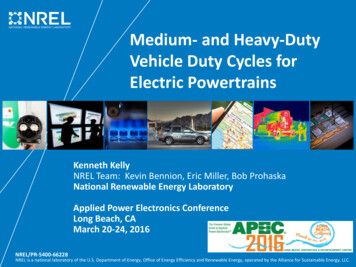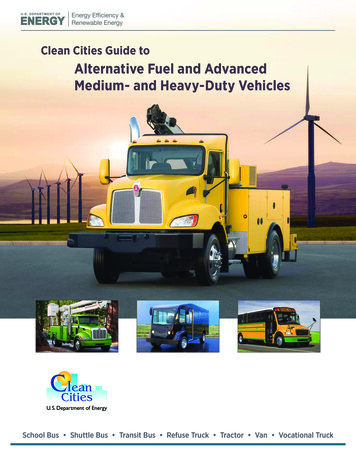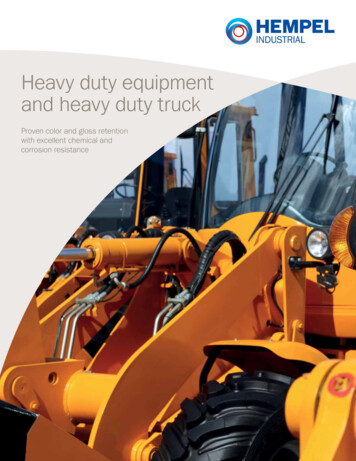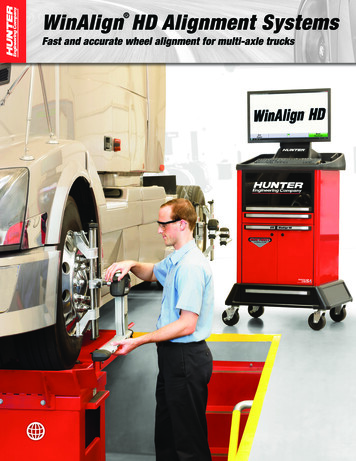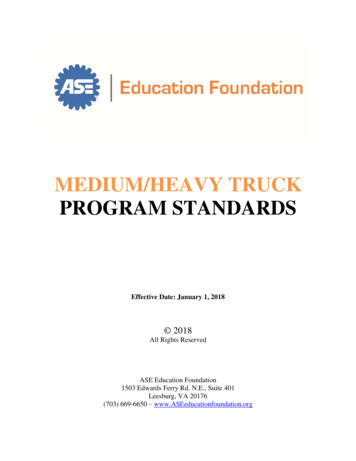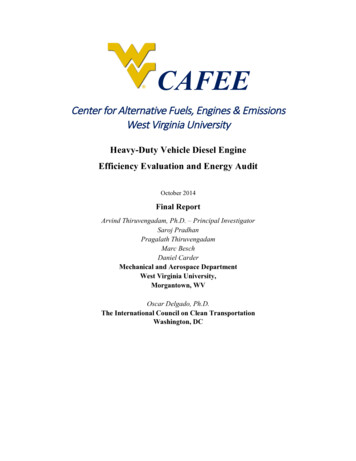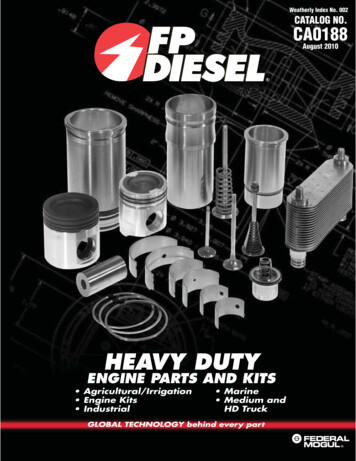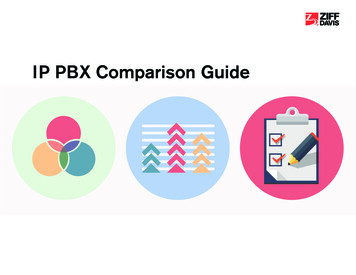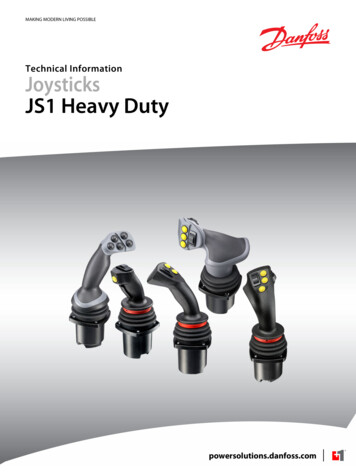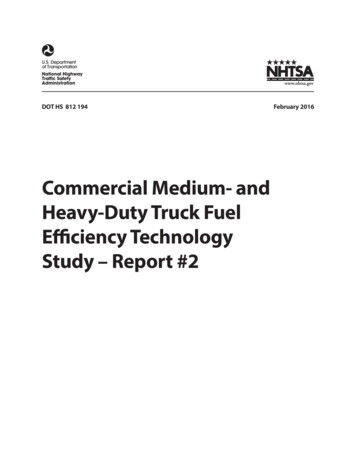
Transcription
DOT HS 812 194Commercial Medium- andHeavy-Duty Truck FuelEfficiency TechnologyStudy – Report #2February 2016
This publication is distributed by the U.S. Department ofTransportation, National Highway Traffic Safety Administration,in the interest of information exchange. The opinions, findings andconclusions expressed in this publication are those of the authorand not necessarily those of the Department of Transportation orthe National Highway Traffic Safety Administration. The UnitedStates Government assumes no liability for its content or usethereof. If trade or manufacturers’ names or products arementioned, it is because they are considered essential to the objectof the publication and should not be construed as an endorsement.The United States Government does not endorse products ormanufacturers.Suggested APA Format Citation:Reinhart, T. E. (2016, February). Commercial medium- and heavy-duty truck fuel efficiencytechnology study – Report #2. (Report No. DOT HS 812 194). Washington, DC: NationalHighway Traffic Safety Administration.
TECHNICAL REPORT DOCUMENTATION PAGE1. Report No.2. Government Accession No.3. Recipient's Catalog No.DOT HS 812 1944. Title and Subtitle5. Report DateCommercial Medium- and Heavy-Duty Truck Fuel EfficiencyTechnology Study – Report #2February 20167. Author(s)8. Performing Organization Report No.Thomas E. Reinhart, Institute EngineerSwRI Project No. 03.178699. Performing Organization Name and Address10. Work Unit No. (TRAIS)Southwest Research Institute6220 Culebra Rd.San Antonio, TX 7823811. Contract or Grant No.6. Performing Organization CodeGS-23F-0006M/DTNH2212-F-0042812. Sponsoring Agency Name and Address13. Type of Report and Period CoveredNational Highway Traffic Safety Administration1200 New Jersey Avenue SE.Washington, DC 20590Final Technical Report14. Sponsoring Agency CodeNHTSA/NRM-32015. Supplementary NotesPrepared for:James MacIsaac (COR)Dr. John Whitefoot (Alternate COR)U.S. Department of TransportationNational Highway Traffic Safety AdministrationFuel Economy Division, NVS-1321200 New Jersey Avenue SE.Washington, DC 20590Coralie CooperU.S. Department of TransportationVolpe National Transportation Systems CenterEnergy Analysis and Sustainability Division55 BroadwayCambridge, MA 02142-109316. AbstractThis research project is to inform NHTSA and EPA’s development of Phase 2 GreenhouseGas Emissions and Fuel Efficiency Standards for Medium- and Heavy-Duty Engines andVehicles (Class 2b – 8). A preceding report (Report #1) evaluated individual potential engineand vehicle fuel savings technologies over a wide range of duty cycles. This report evaluatesthe effectiveness of packages of those individual technologies as well as other related topics.After an introduction, Section 2 includes fuel consumption simulation results for both engineand vehicle technology packages in Class 2b through Class 8 trucks. Section 3 describes theresults of parameter sweep studies, covering aerodynamic drag, tire rolling resistance, vehicleempty weight, and axle ratios. Section 4 covers a brief review of vocational truckspecification issues, and Section 5 is a survey of natural gas vehicle costs, along with someimplementation issues for natural gas powered vehicles. Section 6 provides an overview ofoverall performance simulation project conclusions.Note: This report was subjected to external peer review per OMB guidelines for a Highly Influential ScientificAssessment (HISA). Materials from the peer review process are publicly available in accompanying documents.17. Key Words18. Distribution StatementFuel consumption, GHG emissions, medium duty, heavy Document is available to the public fromduty, engine simulation, vehicle simulation, hybrid the National Technical Informationvehicles, vocational truck, truck specification, natural gas Service www.ntis.govtruck, natural gas truck cost19. Security Classif. (of this report)UnclassifiedForm DOT F 1700.7 (8-72)20. Security Classif. (of this page)Unclassified21. No. of Pages276Reproduction of completed page authorizedi22. Price
EXECUTIVE SUMMARYIn 2011, the National Highway Traffic Safety Administration and EnvironmentalProtection Agency (EPA) jointly issued a first phase of fuel efficiency and greenhouse gas(GHG) standards that apply to medium- and heavy-duty on-highway engines and vehicles formodel years (MY) 2014 to 2018 and beyond. These regulations are commonly referred to as“Phase 1” of the Heavy-Duty National Program. The standards cover all vehicles in weightclasses 2b through 8, which encompasses most vehicles with gross vehicle weight ratings(GVWR) over 8,500 pounds except for a limited number of passenger vehicles covered underthe light duty corporate average fuel economy (CAFE) standards, and recreational vehicles,which were included in EPA’s GHG standards but not NHTSA’s fuel efficiency standards.Phase 1 has two implementation stages. EPA’s greenhouse gas emission standards aremandatory beginning with MY 2014. NHTSA’s fuel consumption standards are voluntary inmodel years 2014 and 2015, becoming mandatory with model year 2016 for most regulatorycategories. Commercial trailers were not regulated in Phase 1. The Phase 1 GHG and fuelconsumption standards were developed using input from a number of studies that evaluatedthe fuel saving technologies that are available, such as the NESCCAF 2009 report [1] and theNHTSA and NAS 2010 reports [2], [3].The research project described in this report has been completed for NHTSA to help toinform the next phase (“Phase 2”) of the regulations, which would set standards incoordination with EPA for model years beyond Phase 1. In order to prepare for Phase 2,NHTSA directed SwRI to update prior research on fuel saving technologies to reflect theeffects of the Phase 1 regulations, as well as to include technical progress that has been madeover the last few years. In particular, SwRI was tasked with assessing the current commercialfleet technology baseline at the time of contract award (MY 2011/2012) and assessing theeffectiveness and cost of potential fuel efficiency/GHG improving technologies for the Phase2 timeframe (post MY 2018 for vehicles and engines).When considering potential fuel efficiency/GHG-reducing technologies, NHTSAdirected SwRI to include a range of factors: design, functionality, duty cycle, use (type ofwork done by the vehicle), and factors that can influence the effectiveness, feasibility, andcost. Vehicle safety, utility, and performance are also to be considered.Final Report #1 of this project [4] covered a literature review, creation of a list ofengine and vehicle technologies to be evaluated in the program, and the list of engines andvehicles to be evaluated. Report #1 also provides the results of simulation studies for theindividual engine and vehicle technologies over a range of drive cycles and payloads. Section3.4 of Report #1 addresses the trade-offs between engine-out NOx and fuel consumption.Section 4 addresses testing and simulation approaches, including appropriate efficiencymetrics. Certain certification issues are also addressed. Section 4.3 of Report #1 coversworldwide regulatory approaches for truck fuel consumption and GHG emissions.ii
In this second technical report, the results from the following tasks are provided:Results from simulation of both engine and vehicle technology packages.The results of parameter sweep studies, covering aerodynamic drag, tire rollingresistance, vehicle empty weight, and axle ratios.A brief review of vocational truck specification issues.A survey of natural gas vehicle costs, along with some implementation issues fornatural gas powered vehicles.Except for the natural gas vehicle cost survey, this project involves simulation resultsthat were supported by experimental data wherever possible. See Section 2.2 regarding theaccuracy and limitations of the simulation techniques used in this project.LONG HAUL TRUCKS AND ENGINESBased on the technologies studied in this project, it appears that there is the potentialto improve long haul truck engine fuel consumption by 2-5% without a waste heat recoverysystem, and by 6% to 9% with a waste heat recovery system. These improvements areachieved compared to the 2019 baseline on cruise speed cycles. Achieving this level of benefitrequires the use of complex and expensive technologies that are not yet fully developed, suchas a waste heat recovery system (see [5] for cost information). The potential fuel savingsachievable using an aggressive friction reduction package and downspeeding are in the 2% to5% range.It should be pointed out that 6-9% fuel consumption reduction with waste heatrecovery system is obtained on the cruise speed cycles. Because waste heat recovery systemshave a slow transient response, the benefit will be much lower on transient cycles. Whenevaluating technology benefits over the agencies’ regulatory cycles, the benefits will be lessthan these numbers quoted here. This is because composite weighting is used over threecertification cycles – 55 and 65mph cruise and the CARB transient cycle. For a long haultractor with high roof sleeper, CARB, 55mph and 65mph use weightings of 5%, 9% and 86%,respectively. Therefore, even though up to 9% benefits can be obtained on the 65mph cruisecycle, the total composite certification cycle benefits with the weighting factors will be about0.5-1% less than 6-9% presented in this report.It should be also pointed out that all technology improvements under considerationhere are based on a long haul truck engine used in a tractor with a high roof sleeper. Some ofkey technologies, such as waste heat recovery, would not be effective for a day cab engine,and therefore the overall benefits over the agencies’ certification categories would be furtherreduced. Another point is that this study assumes that all technologies under considerationwill be realized in a long haul tractor engine. However, in reality, not all technologies can beapplied to all engines on market in the Phase 2 time frame. For example, it is unrealistic toassume that the waste heat recovery system would be 100% used for all engines in Phase 2,because of its high cost and uncertainties of reliability and warranty.iii
An aggressive reduction in Cd (25%) and Crr (30%) provides a 20% fuel consumptionreduction on the long haul NESCCAF cycle. Savings are slightly higher under steady-statecruise conditions (55 and 65 MPH). Other vehicle improvements such as a reduction inaccessory power demand (such as the air conditioner), reduced chassis friction, and 6X2 axlescan add another few percent in fuel savings. T700 vehicle package 4 combined all of thepreviously mentioned features with an engine featuring waste heat recovery and othertechnologies, and it achieved a fuel consumption reduction of 29% on the NESCCAF cycle,with slightly higher savings on the steady-state cruise cycles. This amounts to almost a 50%MPG improvement, which is the goal of the SuperTruck program.Since long haul vehicles tend to have high annual VMT and fuel costs, the segmentcan support a higher investment in fuel saving technology, while still offering an acceptablepayback. Note that this report does not include any cost/benefit analysis. However, note that asignificant amount of R&D will be required to make improvements on this scale productionfeasible and cost-effective.Bringing trailers into the regulatory scheme has significant potential benefits. Traileraerodynamics and tire rolling resistance make a substantial contribution to overall vehiclepower demand. In many cases, ownership of the tractor and trailer is different, so trailerowners may not directly benefit from any fuel savings the trailer provides. Also, many in theindustry have pointed out that greater aerodynamic benefits can be realized if a trailer isoptimized for a particular tractor design, rather than making generic improvements to thetrailer without consideration of the tractor configuration.VOCATIONAL AND MEDIUM DUTY TRUCKSBecause vocational and medium duty trucks tend to have a much lower annual VMT,they burn much less fuel per year. This makes the hurdle for achieving cost-effective fuelsaving technologies much higher. Vocational/MD trucks also tend to operate on lower speed,more transient drive cycles. This reduces the potential benefits of both Cd and Crrimprovements. Many vocational/MD trucks have custom bodies fitted, which are designed toaccomplish a specific work task (dump trucks, cement mixers, waste haulers, utility servicetrucks, oil field service trucks, tanks, flatbeds, box delivery trucks, etc.) The variety and oftenlow technical capability of the body manufacturers makes aerodynamic improvements aparticular challenge. Nevertheless, there are still some fuel savings that can be achieved.Many vocational and medium duty trucks have opportunities for fuel savings that wereoutside of the scope of this project. Examples include reduced cooling fan power demand andimproved efficiency of engine driven accessories such as hydraulic and power-take offsystems.Based on the technologies evaluated in this project, it appears that medium duty dieselengines have the potential for fuel savings of 2% to 4% beyond the Phase 1 regulatoryrequirement. The largest potential benefit comes from friction reduction. In some cases,downsizing of the diesel engine may be beneficial, with potential fuel savings of 5% or moreon vehicles with relatively light duty cycles.iv
Gasoline engines have traditionally suffered from a 25% to 30% fuel consumptionpenalty on a per gallon basis in medium trucks. About 13% of this penalty is due to the lowerenergy content of a gallon of E10 gasoline compared to diesel, but the rest of the penalty isdue to lower brake thermal efficiency of the gasoline engines. However, with the technologiesexplored in this project, gasoline engines show considerable improvement potential. Both thesmall, boosted V-6 and the conventional, naturally aspirated V-8 show the potential for about8% fuel consumption reduction from their respective baselines on the drive cycles evaluatedin this project. The fuel consumption improvement is even larger at high loads, whereenrichment can be eliminated. The downsized and boosted gasoline engine, with technologiessuch as EGR and VVA (P16), has the potential to match or beat the thermal efficiency of the2019 baseline diesel on relatively low speed transient drive cycles, as shown in Table 6.1. TheV-8 engine has GDI EGR cylinder deactivation 10% FMEP reduction (P20). Data forthe baseline 6.2 liter V-8 is provided in the following table for reference.FUEL CONSUMPTION COMPARISON IN T270 TRUCKEngineFuel Consumption Penalty on Drive Cycle at 50% Payload vs. 2019Baseline Diesel EngineCARB 55 MPH 65 MPH WHVC CILCC Parcel Average2019 ISB (D)Baseline Baseline Baseline Baseline Baseline Baseline Baseline3.5 V-6 P16 (G)9.9%19.6%18.4%12.9%3.7%5.1%11.6%6.2 V-8 P20 (G)18.6%25%21.7%19.9%13.9%14.2%18.9%Base 6.2 V-8 (G)31.2%33.5%36.3%30.4%28.3%23.4%30.5%(D) Diesel, (G) GasolineThe results in the tables here are in terms of fuel consumption on a volume basis(gallons). The fuel consumption of the gasoline engines in gallons is compared to the fuelconsumption of the 2019 diesel in gallons. A fuel consumption increase of less than 13%would indicate that the gasoline engine is more efficient than the diesel, because of the lowerenergy content of a gallon of gasoline. A fuel consumption penalty of over 13% indicates thatthe gasoline engine is less efficient than the diesel.The advantage for the downsized, boosted V-6 comes primarily from operating at ahigher BMEP under light load conditions, due to the smaller displacement. At higher averageloads, such as those found on the 55 and 65 MPH cruise cycles on the T270 truck with a highfrontal area, the diesel engine retains a thermal efficiency advantage. Under extreme load,such as going up a grade at high speed or towing a heavy trailer, the diesel will retain asubstantial efficiency advantage, but it will be less than the historical situation.For medium-duty trucks, the fuel savings potential from a 20% reduction in rollingresistance and a transmission with more ratios (8) and higher mechanical efficiency is in therange of 4% to 6%. If an idle neutral feature is added to the transmission, the fuel savingsexceed 14% on the Parcel cycle with the diesel engine, which includes 50% idle time. The V6 achieves slightly higher fuel savings from the Crr reduction and 8-speed automatic than thev
diesel, and the V-8 slightly less. The gasoline engines benefit less from an idle neutral feature,because their looser torque converter allows less idle power demand on the gasoline engines.PICKUP TRUCKS AND ENGINESHeavy duty (3/4 and 1 ton) pickup trucks operate under a huge range of duty cycles.Some are primarily used for passenger transport, while others frequently tow heavy trailerswith bulky loads. This makes evaluating technologies a challenge. For example, cylindercutout on the gasoline V-8 may provide a significant benefit at zero payload on low speeddrive cycles, but zero benefit on the highway with a load.Based on the technologies evaluated in this project, it appears that medium duty dieselengines have the potential for fuel savings of 3% to 4% beyond the Phase 1 regulatoryrequirement. The largest potential benefit comes from friction reduction. In many cases,downsizing of the diesel engine may be beneficial, with potential fuel savings of 6% to 12% atALVW over the full range of drive cycles. For most driving situations, 385 HP and 850 lb-ftare simply not needed, and downsizing could save significant fuel. However, for those fewtrucks that actually operate near GCW much of the time, the downsized engine will notprovide a fuel savings, and the performance penalty will be substantial.The fuel savings technologies applied to the small, boosted V-6 gasoline engine in thepickup truck yield similar benefits to those obtained in their medium truck applications. In theV-8, cylinder cutouts perform better than in the medium trucks, because with a smaller, lightervehicle, there is more opportunity to shut cylinders down. Table 6.2 compares gasoline anddiesel engine performance at ALVW payload (approximately 1,600 pounds in the cargo bed).Note that the 2019 ISB baseline is different from the one in the table above, because this is a3,000 RPM pickup truck rating. The gasoline ratings are the same as for medium trucks.FUEL CONSUMPTION COMPARISON IN PICKUP TRUCKEngineFuel Consumption Penalty on Drive Cycle at 50% Payload vs. 2019Diesel Engine BaselineFTPFTPUS06SC03WHVC65AverageCityHwyMPH2019 ISB (D)Baseline Baseline Baseline Baseline Baseline Baseline Baseline3.5 V-6 P16 (G)-5.4%9.0%8.7%-1.2%-0.2%13.5%4.1%6.2 V-8 P20 (G)7.0%17.1%14.9%10.6%12.8%19.6%13.7%Base 6.2 V-8 (G) 22.7%32.7%27.0%29.4%24.9%33.3%28.3%(D) Diesel, (G) GasolineThe advantage for the downsized, boosted V-6 comes primarily from operating at ahigher BMEP under light load conditions, due to the smaller displacement. Compared tomedium trucks, more of the drive cycle time is at light load, so the V-6 performs better inpickups. At higher average loads, such as those found on the 65 MPH cruise cycle, the dieselengine retains a slight thermal efficiency advantage. Under extreme load, such as going up agrade at high road speed or towing a heavy trailer, the diesel will retain a substantialefficiency advantage, but it will be less than the historical situation.vi
For pickup trucks, the fuel savings potential from a 10% reduction in aerodynamicdrag and a 30% reduction in rolling resistance, plus a transmission with more ratios (8) andhigher mechanical efficiency is in the range of 6% to 10% with the diesel and the V-6, andabout 1% less with the V-8. If an idle neutral feature is added to the transmission, the fuelsavings are an additional zero to 4% for the diesel, and zero to 2% for the gasoline engines onthe drive cycles evaluated for this project. Note that the pickup truck was not run on the Parcelcycle, which has the highest portion of cycle time at idle.Hybrid systems were also evaluated on the pickup trucks. These systems ranged froma small belt driven integrated starter generator, through a larger crank driven ISG, to a fullparallel hybrid system. The fuel savings benefits vary with engine and payload. At ALVWpayload (about 8,500 pounds vehicle test weight), the BISG provided a benefit of 5.6% to7.7% on the city cycle. The CIGS provided 7.0% to 8.3% fuel savings on the city cycle, andthe parallel system saved 25.2% to 29.5%. Fuel savings on the highway cycle were muchsmaller for all systems. Other drive cycles were not evaluated.POTENTIAL OF GASOLINE ENGINESGasoline engines have several technologies which offer the potential for fuelconsumption reduction. EGR is of particular interest, because it can eliminate the need forenrichment at high load and because it reduces in-cylinder and exhaust temperatures. Thetemperature reduction can help reduce the gap in durability between diesel and gasolineengines. Simulation results reported in Section 4 indicate that gasoline engines have thepotential to compete with medium duty diesels on efficiency (on a per unit energy basis) andon fuel cost (with a gallon of diesel costing more than a gallon of gasoline). Gasoline enginesalso have the potential to compete with medium duty diesels on a GHG emissions basis.These results depend on the successful implementation of EGR in boosted gasoline engines,and as this technology has yet to be introduced into production, there is some risk associatedwith this approach. The primary market driver for gasoline engines is lower initial cost.Gasoline engines cost less because the engine and aftertreatment are less complex, andbecause their higher operating speeds and lower torques allow use of a lower costtransmission.NATURAL GAS ENGINESNatural gas offers several advantages, including the potential for lower, more stablefuel prices, simpler aftertreatment, and lower GHG emissions. Several states also offer taxincentives for the purchase of natural gas powered vehicles. Balanced against theseadvantages are a number of disadvantages. Class 2b and 3 trucks equipped for natural gas costbetween 6,240 and 15,505 more than comparably equipped gasoline powered vehicles.Medium and heavy-duty trucks with natural gas engines are 37,549 to 76,354 moreexpensive than diesel powered trucks. A large portion of the cost penalty for natural gasvehicles is driven by fuel storage system cost. Natural gas must be stored either under veryhigh pressure or in a well-insulated cryogenic tank. In addition to the purchase price penalty,natural gas requires specific equipment and training for the service shop.vii
Several other factors make natural gas a challenge for truck operations. The fuel tanksize required to store a given amount of energy is about 1.8 times greater for LNG and 4.5times greater for CNG. These larger tanks pose a significant packaging issue, and they arealso substantially heavier than gasoline or diesel tanks. Often, a longer wheelbase is needed topackage adequate fuel capacity, and natural gas vehicles typically offer a shorter range.Another issue is that the stoichiometric, spark-ignited engines that dominate the market havesubstantially lower thermal efficiency than diesel engines. This means that operators cannotjust compare fuel cost on a gallon equivalent basis. They must also take the higher fuelconsumption of natural gas engines into account. Engines that use direct injection of naturalgas, with a diesel pilot to ignite the gas, can be as efficient as the best diesel. Unfortunately,these engines have challenges with meeting methane emissions standards. In addition, theyare so expensive that they have recently been withdrawn from the market.The number of natural gas fueling stations has increased over the last few years, butnatural gas availability remains an issue for vehicles that need the flexibility to be able totravel away from a fixed location. The largest engine currently on the market is 12 liters,which limits the use of natural gas for long haul applications. OEM plans to introduce largerengines have been put on hold, partly due to the drop in diesel fuel prices in 2014.OVERALL SUMMARY OF RESULTSFor the technologies evaluated in this project, the overall fuel savings potential beyondthe Phase 1 standards are shown in the table below. Note that many of these technologies maynot prove to be cost effective.Overall, diesel engines offer a potential for 2% to 5% improvement beyond therequirements of the Phase 1 GHG regulations. Beyond that level, more exotic and untriedtechnologies would be required. Gasoline engines show more potential for improvement,although they start from an efficiency level well below that of diesels. There is the potentialfor gasoline engines to become competitive with diesel in pickups and medium-duty truckapplications.Vehicle CategoryLong HaulMediumDuty/VocationalPickup TruckSUMMARY OF RESULTSEngine or VehiclePotential Fuel and CO2 SavingsEngine2% to 5% w/o WHR, 6% to 9% with WHRVehicleUp to 20% on long haul cycleEngineDiesel: 2% to 4%. Gasoline: 8%Vehicle4% to 6%, more with idle neutralEngineVehicleDiesel: 3% to 4%. Gasoline: 8%6% to 10%Long haul trucks offer the most potential for vehicle power demand reduction, andthus for improved fuel efficiency. There are several factors involved. Long haul drive cyclesmean that power demand is dominated by aerodynamic drag and rolling resistance. There areviii
known technologies to address these two sources of power demand. Vehicles that operate inmore transient duty cycles have a larger share of total vehicle power demand used toovercome (accelerate) vehicle inertia. It is difficult to significantly reduce inertia, especiallywith a large payload. Any reduction in payload actually increases load specific fuelconsumption. Smaller vehicles also have less frontal area than tractor-trailers, which makesthe contribution of aerodynamic drag smaller, and which thus reduces the fuel economyimprovement potential of aerodynamic treatments.A wide range of both engine and vehicle individual technologies were explored inFinal Report #1. After completion of that work, SwRI, NHTSA and EPA agreed oncombinations of technologies to evaluate for the second phase of the project, which are nowdetailed in this report. Since it was not possible to simulate packages with every permutationof the many individual technologies, the staffs selected packages of technologies that wereconsidered appropriate, cost-effective, and technologically feasible in the projected Phase 2timeframe for the particular vehicles studied and their duty cycles. Other technologies orpackages of technologies not included in this study may also offer pathways to increasingMD/HD vehicle fuel efficiency.ix
TABLE OF CONTENTSPage No.EXECUTIVE SUMMARY . IILIST OF FIGURES . XIVLIST OF TABLES . XVILIST OF ABBREVIATIONS AND ACRONYMS . XVIII1.0INTRODUCTION.12.0COMBINED BENEFITS SIMULATIONS .42.1 Technology Combinations .42.1.1 Engine Technology Combinations .42.1.1.1 Vehicle Technology Combinations .72.2 Modeling Methodology .102.3 Results .132.3.1 Class 8 Tractor-Trailer Truck and Engine Technology Combination Results .132.3.2 Summary of DD15 Engine Technology Combinations in the T700 Truck .13Comparison of 2019 Baseline engine to original 2011 baseline2.3.2.1(2011 Base) . 162.3.2.2DD15 Technology Package 1: 2019 Baseline FMEP Reduction (P1) . 172.3.2.3DD15 Technology Package 2: 2019 Baseline Downspeed B ½ FMEPReduction (P2) . 172.3.2.4DD15 Technology Package 3: Package 2 Water Based WHR (P3) . 172.3.2.5DD15 Technology Package 3a: Package 2 R245 Based WHR (P3a) . 182.3.2.6DD15 Technology Package 3b: Package 2 R245 Based WHR withRecuperator (P3b) . 182.3.2.7DD15 Technology Package 3c: Package 2 Methanol Based WHR(P3c) . 182.3.2.8DD15 Technology Package 3d: Package 2 Methanol WHR withRecuperator (P3d) . 182.3.2.9DD15 Technology Package 3e: Package 2 Ethanol Based WHR (P3e) . 192.3.2.10 DD15 Technology Package 3f: Package 2 Ethanol WHR withRecuperator (P3f) . 192.3.2.11 DD15 Technology Package 4: No Turbocompound, Conventional FixedGeometry Turbine,
Heavy-Duty Truck Fuel Efficiency Technology Study – Report #2. . Because waste heat recovery systems have a slow transient response, the benefit will be much lower on transient cycles. When evaluating technology benefits ove
